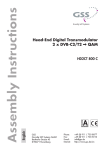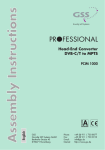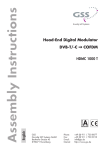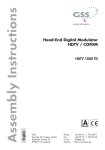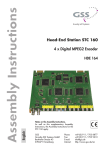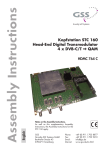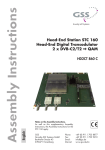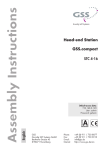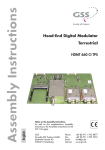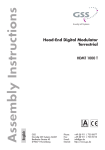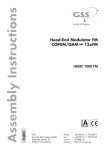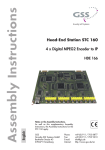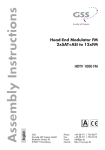Download User Manual
Transcript
Head-End Digital HD Encoder KLASSE HDE 400 English CLASS GSS Grundig SAT Systems GmbH Beuthener Strasse 43 D-90471 Nuremberg Phone: Fax: E-mail: Internet: +49 (0) 911 / 703 8877 +49 (0) 911 / 703 9210 [email protected] http://www.gss.de/en Contents 1 Safety regulations and notes......................................................................... 4 2 General information..................................................................................... 5 2.1 Packing contents.............................................................................5 2.2 Meaning of the symbols used...........................................................5 2.3 Technical data................................................................................5 2.4 Description....................................................................................7 Signal runtime................................................................................8 Software versions...........................................................................9 Block diagram................................................................................9 3 Assembly................................................................................................... 10 3.1 Installing the cassette....................................................................10 3.2 EMC regulations...........................................................................11 3.3 Cassette overview........................................................................12 3.4 Connecting the cassette.................................................................12 4 The control panel at a glance...................................................................... 13 4.1 Menu items..................................................................................13 4.2 Control panel...............................................................................13 5 Programming............................................................................................. 14 5.1 Programming procedure................................................................14 5.2 Programming the cassette..............................................................17 Selecting the cassette....................................................................17 Encoder......................................................................................18 Service ID (SID).......................................................................18 Programme name....................................................................18 Total data rate.........................................................................19 HDMI Video Format.................................................................19 Video signal type/input............................................................20 Group of Picture – GoP............................................................20 Audio input / Audio level.........................................................21 Audio data rate.......................................................................22 RF output.....................................................................................22 Deactivate the RF output...........................................................22 Kind of modulation..................................................................23 RF output level.........................................................................23 Channel / Frequency...............................................................24 Output symbol rate, QAM modulation ........................................ 25 COFDM parameters................................................................26 COFDM output signal . .............................................................. 29 - 2 - HDE 400 Transmission parameters..........................................................30 Transmitter identification...........................................................31 Substitute signal in the case of an incorrect input signal................32 Ethernet parameters......................................................................32 IP address of the cassette..........................................................33 Address range (subnet mask)....................................................33 Address of the gateway...........................................................34 UDP port................................................................................34 IP output signal.............................................................................35 Setting the output data rate.......................................................35 Transmission protocol / Port number..........................................36 Quantity of data packets..........................................................37 Forward error correction / Transmission channel . ......................37 Output IP address....................................................................38 ASI output....................................................................................38 ASI transfer rate......................................................................39 ASI options.............................................................................39 ASI Input station filter; Bypass ASI => RF.........................................40 Output data rate...........................................................................42 Transport stream ID and ORGNET ID..............................................43 Network Information Table (NIT).....................................................43 Factory reset / Soft reset...............................................................44 Factory reset...........................................................................44 Soft reset................................................................................45 Saving settings ............................................................................45 6 Final procedures......................................................................................... 46 7 Channel and frequency tables..................................................................... 47 - 3 - HDE 400 1 Safety regulations and notes • Assembly, installation and servicing should be carried out by authorised electricians. • Switch off the operating voltage of the system before beginning with assembly or service work or pull out the mains plug. • Do not perform installation and service work during thunderstorms. • Install the system so it will not be able to vibrate… - in a dust-free, dry environment - in such a manner that it is protected from moisture, fumes, splashing water and dampness - somewhere protected from direct sunlight - not within the immediate vicinity of heat sources - in an ambient temperature of 0 °C to +50 °C. In case of the formation of condensation wait until the system is completely dried. • Ensure that the head-end station is adequately ventilated. Do not cover the ventilation slots. • Beware of short circuits • No liability is accepted for any damage caused by faulty connections or inappropriate handling. • Observe the relevant standards, regulations and guidelines on the installation and operation of antenna systems. • The standards EN/DIN EN 50083 resp. IEC/EN/DIN EN 60728 must be observed. • For further information please read the assembly instructions for the headend station used. • Test the software versions of the head-end station and the cassette and update them if necessary. The current software versions can be found at "www.gss.de/en". Take action to prevent static discharge when working on the device! Electronic devices should never be disposed of in the household rubbish. In accordance with directive 2002/96/EC of the European Parliament and the European Council from January 27, 2003 which addresses old electronic and electrical devices, such devices must be disposed of at a designated collection facility. At the end of its service life, please take your device to one of these public collection facilities for proper disposal. - 4 - HDE 400 2 General 2.1 Pac k i n g contents 1 Cassette HDE 400 1 Brief assembly instructions 2.2 M e a n i n g o f t h e s ym b o l s u s e d Important note —> General note • Performing works 2.3 T e c h n i c a l information data The devices meet the following EU directives: 73/23/EWG, 89/336/EWG The product fulfils the guidelines and standards for CE labelling (page 48). Unless otherwise noted all values are specified as "typical". HDMI Input Tested Video Formats..............1920x1080p24/i50/p50/i60, 1280x720p50/p60, 720x576i50/p50, 720x480i59/p59 Supported Audio Formats........................................................ Linear PCM Component Video Input Input level...............................................................Y 1 Vss, Pb/Pr 0,7 Vpp Input impedance.............................................................................. 75 Ω Tested Video Formats.......... 1920x1080i50, 1280x720p50, 720x576p50, 720x480p59 Supported standards...........................................................................PAL CVBS Video Input Input level....................................................................................... 1 Vpp Input impedance.............................................................................. 75 Ω Frequency range............................................................ 20 Hz … 5 MHz Supported standards..................................................................... PAL BG Audio Input Input level................................................................................500 mVrms Frequency range............................................................20 Hz … 15 kHz - 5 - HDE 400 MPEG4 Encoder Transport stream.....................................H.264/AVC High Profile Level 4.0 Setting range of total data rate (video + audio + tables)............ 1 Mbit/s…30 Mbit/s Video data rate: 1920x1080p........................................................... 6 Mbit/s…30 Mbit/s 1920x1080i............................................................ 6 Mbit/s…24 Mbit/s 1280x720p............................................................. 4 Mbit/s…24 Mbit/s 720x576i................................................................ 1 Mbit/s…10 Mbit/s 720x480i................................................................ 2 Mbit/s…10 Mbit/s Audio data rate.......................................................... 32 kb/s…384 kb/s RF Output COFDM Frequency range............................................... 42.0 MHz … 860.0 MHz Channels............................................................C5 … C12, C21 … C69 Transmission mode............................................................................... 2k Kinds of modulation.......................................... QPSK, 16 QAM, 64 QAM Code rates........................................................ 1/2, 2/3, 3/4, 5/6, 7/8 Guard intervals..................................................... 1/4, 1/8, 1/16, 1/32 Return loss....................................................................................> 8 dB Output level............................................................................... 96 dBμV Output impedance........................................................................... 75 Ω RF Output QAM Frequency range............................................... 42.0 MHz … 860.0 MHz Channels.............................................................................. S21 … C69 Kinds of modulation....................................QAM 4, 16, 32, 64, 128, 256 Output level............................................................................... 96 dBμV Output impedance........................................................................... 75 Ω ASI Interfaces Norm............................................................................DIN EN 50083-9 Format................................................................MPEG ISO IEC 13818-1 Max. data rate....................................................................... 108 Mbit/s Impedance...................................................................................... 75 Ω Level (input / output).......................................................800 mVpp ± 10% Return loss (input)................................................> 17 dB (5 … 270 MHz) LAN Interface Standard................................................................. 10/100/1000 MB/s Transport stream.............................MPTS (Multi Programme Transport Stream) Protocols............................................................ UDP (User Data Protocol), RTP (Real-Time Transport Protocol) - 6 - HDE 400 Connections Video Inputs: HDTV............................................................ 1 HDMI 1.4a (typ A, 19 Pin) Component YPbPr............................................................. 3 Cinch sockets CVBS................................................................................1 Cinch socket Audio Inputs: PCM.................................................................................. 1 HDMI 1.4a S/PDIF (PCM)..........................................................................1 TOSLINK Analogous Stereo ............................................................ 2 Cinch sockets LAN.................................................................................. 1 RJ 45 socket ASI input...................................................................1 BNC socket, 75 Ω ASI output..................................................................1 BNC socket, 75 Ω RF output...................................................................... 1 IEC socket 75Ω Connection strip (10-pin):.........................................for supply voltages and control circuit RS-232 socket:........................................................ serial update interface Remote maintenance Remotely controllable (via PSW 1000*):............................................... yes Remote update (via BEflash*):.............................................................. yes (* and a corresponding management unit) 2.4 D e s c r i p t i o n The MPEG4 Encoder Cassette converts a HD or SD video and audio signal into a MPEG4 data stream (transport stream) and outputs it via the ASI interface, the LAN interface and the RF output. COFDM or QAM modulation can be selected for the RF output signal. For the Video input it can be selected between HDMI (HDTV with PCM stereo sound), YPbPr (SD/HD) or CVBS (SD). All common HDTV formats up to a resolution of 1920 × 1080p @ 50/60Hz are supported. The stereo audio signal of a YPbPr resp. CVBS signal can be fed in via the cinch sockets (analogous) or the TOSLINK S/PDIF interface (PCM). A status LED at the HDMI socket lights green, if the present signal is supported (suitable resolution, no copy protection), or red, if no or a not supported signal is present. A status LED at the ASI input indicates, whether a input signal is present (green). - 7 - HDE 400 The MPEG4 encoder generates a transport stream according to H.264/AVC (Advanced Video Coding) High Profile Level 4.0 standard. At the LAN socket a MPTS transport stream (Multi Programme Transportstreams, adjustable data rate) according to UDP or RTP protocol can be output. —> Live Streaming/Multicast Streaming requires specially designed and configured networks. Minimum Requirements include: Layer-3 Switched Ethernet, Multicast Enabled, IGMPv2/3, Network and Multicast Routing Supported. The transport stream can be cascaded via ASI. IPTV ASI QAM/ COFDM The cassette is designed for use in head-end stations of the standard line. The operating software of the cassette can be updated via the 9-pin D-SUB socket "RS-232" using a PC or notebook and the software "BE-Flash". You can find the current operating software on the website "www.gss.de/en". Signal Channel switching at a HD source, becomes effective only after a time delay (of up to 3 seconds) because of the signal runtime! runtime - 8 - HDE 400 S o f t wa r e Cassette After activating the cassette the software version of the cassette is displayed (see page 17). Control unit To operate these cassettes the software version of the control unit must be "V44" or higher. Approximately 5 minutes after the last keypress the software version of the control unit is displayed. If necessary, you can activate the indication of the software version of the control unit manually: • Press any two keys on the control unit of the head-end station simultaneously until the display goes dark and the software version, e.g. "V 44" appears. B lo c k v e rs i o n s d i ag r a m ASI-Eingang ASI input BNC all => RF ASI-Ausgang ASI output BNC all, manual Bx 2 FILTER all Audio Audio Bx 2 ENCODER L AUDIO-IN 0 dB PCM TPS HDMI TS all, manual QAM/COFDM-Modulator R all => RF PCM µP / TPS-MODUL SPDIF HF Ausgang HF output HDTV Y/FBAS Y/CVBS FBAS/CVBS Video Pb Pr IPTV OUT Component - 9 - HDE 400 3 Assembly 3.1 I n s ta l l i n g the cassette – Ensure the head-end station is mounted so it will not be able to vibrate. Avoid, for example, mounting the head-end station onto a lift shaft or any other wall or floor construction that vibrates in a similar way. – Before installing or changing a cassette unplug the power cable from the mains power socket. • Remove the fastening screws 1 of an unoccupied slot from the bracket of the head-end station. • Insert the cassette in this slot and push it into the housing. • Align the cassette and apply slight pressure to connect it to the connections of the board and the HF bus bar. • Fasten the cassette with the screws 1. 1 1 - 10 - HDE 400 3.2 EMC KLASSE CLASS r e g u l at i o n s To comply with the current EMC regulations, it is necessary to connect the lines leading in and out of the head-end station using cable terminals. When mounting the cassette in a head-end station which is installed in a 19" cabinet, make sure the connections leading in and out for the 19" cabinet are made using cable terminals. The attenuation of shielding of the connection lines for ASI and antenna must meet the requirements for "Class A". • Insert the required number of cable terminals in the openings provided in the head-end station or in the 19" cabinet. Tighten the nuts on the cable terminals until the teeth on the lock washer have penetrated the exterior coating and a good connection is made between the housing and cable terminals. Whenever the HDMI socket is used, the player, which is connected to it, must be operated inside the station or connected via commercially available optical fibre, in order to fulfill the EMV regulation for head-end stations. - 11 - HDE 400 3.3 C a s s e t t e ov e rv i e w 1 2 3 4 5 6 7 8 9 10 11 12 13 14 15 3.4 C o n n e c t i n g D-SUB socket "RS 232" Status LED network LAN socket Status LED data transfer ASI output ASI input Status LED ASI input OPTICAL S/PDIF PCM audio input TOSLINK Audio input R analogous Audio input L analogous Video input Y/CVBS Video input Pb Video input Pr HDMI input Status LED HDMI The operating software of the cassette can be updated via the 9-pin D-SUB socket "RS 232" using a PC or notebook and the software "BE-Flash". You can find the current operating software on the website "www.gss.de/en". the cassette • Dependent on the input signal connect the source device via cable terminals to the input sockets "HDMI" $, "Y/Pb/Pr" !/@/# or "CVBS" !, "Audio R" 9, "Audio L" 0 or "OPTICAL" 8. • If necessary connect the ASI input 6 and the ASI output 5 to the peripheral devices - and/or • connect the LAN socket 3 to a LAN network. • Connect the head-end station to the mains. 1 2 3 4 5 6 7 8 9 0 ! @ # $ % - 12 - HDE 400 4 The control panel at a glance 4.1 M e n u items Program the cassette using the buttons on the control unit of the head-end station. The two-line display of the control unit then shows the menus. Use the key to select the following main menu items: – – – – – – – – – – – Cassette Encoder RF Output Ethernet IPTV Output ASI Output ASI Input Data rate TS/ONID NIT Factory reset 4.2 C o n t r o l V44 please wait . . . pa n e l The key pad on the head-end station is used to scroll through the menus: scrolls forward through the menus. scrolls backward through the menus. select parameters in the menus selects sub-menus BE-Remote set values,. saves all entries. - 13 - HDE 400 5 Programming 5.1 Progr a mming BE–Remote Ein/On procedure V 44 Bedienhinweise "blättert" Menüs vorwärts. "blättert" Menüs rückwärts. wählen die Eingabeposition wählt Untermenü stellen Werte ein,. speichert alle Eingaben. 1 zeigt die Eingabeposition please wait … t > 10 s Bx 1 ……… ……… ……… A (Page 16) Bx 2 ENCODER Bx 3 ……… V6 HD ……… ……… ––– (Page 16) B Bx 2 > 2 sec. = abbrechen / cancel ENCODER HD => Bx 2 Operating Hints scrolls forward through the menu. scrolls backward through the menu. select the enter position. selects a submenu. set values and triggers actions. saves all entries. 1 shows the enter position SERVICE-ID 00001 Bx 2 NAME löschen / delete HD Bx 2 BITRATE 10.0 Mbps Bx 2 HDMI-LIMIT auto (save) 1.0 … 30.0 Mbps Off Audio only nach Änderung (save) after modification (save) Bx 2 VIDEO-IN HDMI nc Bx 2 VIDEO-GOP IBBP 0 dB CINCH Bx 2 QAM RF C69 => Bx 2 AUDIO 192 kbps Stereo Bx 2 - 14 -LEVEL - 6 dB Bx 2 HDMI-LIMIT store HDMI yPbPr CVBS IBBP IPPP IBP AUDIO-IN Bx 2 A auto 1080i50 720p50 Bx 2 CINCH OPTICAL HDMI AUDIO-IN 0 dB HDE 400 Bx 2 QAM RF C69 Bx 2 LEVEL - 6 dB => OFF/QAM/COFDM Bx 2 FREQ C69 858.00 MHz QAM COFDM Bx 2 QAM Bx 2 COFDM 6900 QAM 256 POS 8MHZ Bx 2 FAILURE Bx 2 Tables 2k QAM64 POS COFDM C7/8 Bx 2 G1/32 CELL-ID 0x0000 Bx 2 off FAILURE Tables Bx 2 off ETHERNET => stat DHCP Bx 2 IP-ADDR 192.168. 0.128 Bx 2 IP-MASK 255.255. 255. Bx 2 0 IP-GATEWAY 192.168. 0. Bx 2 1 UDP-PORT 60000 Bx 2 IP OUTPUT => IP 1 DATARATE ( 7.3) > IP 1 MODE/PORT UDP 1234 IP 1 7 ◀ / ▶ auto 2 … 80.0/180.0 MBits ! 10.0 MB /RTP PKTS/FEC - 15 - off HDE 400 1…7 / 10/09 AnnexB / … / 20/19 AnnexB 1234 UDP PKTS/FEC IP 1 7 off 1…7 / 10/09 AnnexB / … / 20/19 AnnexB IP 1 OUT-IP 227. 40. Bx 2 OUTPUT ASI 50. 60 ASI RATE Bx 2 => /RTP 108000 KBits ASI OPTION Bx 2 cont. 188 pos. Bx 2 INPUT Bx 2 ASI OK => all FILTER /204 /neg. /burst all manual all => RF nur bei Einstellung "manual" Only with setting "manual" BX 2 TV + Services entfernen / hinzufügen Removing / activating services 01/04 Das Erste Bx 2 ! nächster Service (Programm) next service (station) DATARATE 38.3/ 50.9 Mb Bx 2 TS/ONID 0x0001,0100 Bx 4A/B off NIT => Make ▶ Make (Page 14) A on / off Bx 4 Defaults FACTORY => ▶ Bx 4 FACTORY STORE Bx 4 RESET RESET => M => M - 16 - auf Werkseinstellung zurücksetzen und speichern M reset to factory defaults and store (Page 14) A M (Page 14) B HDE 400 5.2 P r o g r a m m i n g the cassette —> Pressing the button for longer than 2 seconds cancels the programming procedure. This takes you back to the programme item "Selecting the cassette" from any menu. Any entries that have not been saved are reset to the previous settings. —> Entries in the menus can be saved by pressing the key. You are taken back to the "Selecting the cassette" menu item. —> The parameters and functions to be set are underlined (Cursor). • Switch on the head-end station. —> The display shows the software version (e.g. V 44) —> The processor reads the cassettes‘ data (approximately 10 seconds). Ein/On BE–Remote V 44 please wait … t > 10 s Selecting the cassette Bx 1 ……… ……… ……… Bx 2 ENCODER Bx 3 ……… V6 HD ……… ……… ––– • If necessary select the cassette to be programmed by repeatedly pressing the button (e.g. Box 2). —> • Press the The display shows e.g. the menu "Bx 2 ENCODER": "Bx 2" stands for slot 2 "ENCODER HD" type of cassette "V 6" software version of the cassette button. —> The "Encoder settings" – "ENCODER" main menu is activated. - 17 - HDE 400 Encoder Via this menu you get access to the submenus in order to do the encoder settings and to select the desired input. —> If no encoder settings should be done, press button The "RF output" – "RF" main menu is activated (page 22). • Press button . . —> The "SERVICE-ID" submenu is activated. S e rv i c e ID (SID) In this menu you can assign a Service ID for the signal which is to be encoded. Bx 2 SERVICE-ID 00001 • Use the buttons to select the digit of the SID to be set and use buttons to set the desired SID. —> Take care, not to assign the same SID twice. • Press the button. —> The "Channel name" – "NAME" submenu is activated. Progr a mme In this menu, a programme name for the signal which is to be encoded, can be set. name Bx 2 NAME HD • Use the use buttons to select the digit of the channel name to be set and buttons to set the desired character . —> Press button to delete the complete name. - 18 - HDE 400 • Press the button. —> The "Total data rate" – "BITRATE" submenu is activated. T ota l In this menu you set the total data rate (video + audio + tables), with which the input signal shall be encoded. data r at e Bx 2 BITRATE 10.0 Mbps —> The higher the resolution of the input video signal, the higher the data rate must be set: 1920x1080p 6,3 Mbit/s…30 Mbit/s 1920x1080i 6,3 Mbit/s…24 Mbit/s 1280x720p 4,3 Mbit/s…24 Mbit/s 720x576i 1,3 Mbit/s…10 Mbit/s 720x480i 2,3 Mbit/s…10 Mbit/s • Use the buttons to set the data rate of the video signal (1.0…30.0 Mbit/sec). If only audio signals are to be encoded, set the data rate to "Audio only". In setting "Off" the encoder is switched off. • Press the button. —> The "HDMI Video Format" – "HDMI-LIMIT" submenu is activated. HDMI V i d e o F o r m at In this menu you can limit the HDMI video format from "automatic" to a fixed maximum value if e.g. the communication with a DVD player fails. Bx 2 HDMI-LIMIT auto (save) • Use the buttons to limit the HDMI video format of the video signal: – "auto": one of the available video formats 480i/p, 576i/p, 720p, 1080i/p will be set automatically. - 19 - HDE 400 – "1080i/50": A maximum HDMI video format of 1080i/50Hz will be communicated to the source player. – "720p/50": A maximum HDMI video format of 720p/50Hz will be communicated to the source player. • Press the button. —> The "Video signal type/input" – "INPUT" submenu is activated. Vi d e o s i g n a l t y p e /i n p u t In this menu you select whether you would like to feed in a HD video signal "HDMI" via the HDMI socket, a Composite video signal "YPbPr" via the green/ blue/red cinch sockets or a CVBS video signal "CVBS" via the green cinch socket. Bx 2 VIDEO-IN HDMI • Use the nc buttons to select the desired type of video signal / input. —> If HDMI is selected, a missing input signal is indicated by"nc". • Press the button. —> The "Group of Picture" – "VIDEO-GOP" submenu is activated. Group The GoP describes the order of reference and difference pictures of the data stream. This influences the compression. of P i c t u r e – G o P Bx 2 VIDEO-GOP IBBP • Use the buttons to select the desired "Group of Picture" (GoP). —> IBBP – high compression – HDTV at low data rate for "normal picture contents" at higher channel switching delay. IBP – medium compression – HDTV at medium data rate for "fast moving contents" (e.g. sport) at medium channel switching delay. - 20 - HDE 400 IPPP - minor compression – HDTV at high data rate for "fast conversion" at short channel switching delay. —> At a resolution of 1080p the setting "IPPP" is not available. • Press the button. —> The "Audio input/Audio level" – "AUDIO-IN" submenu is activated. Audio If the "yPbPr" or " CVBS" video input is selected in menu "VIDEO-IN", herein you can select the audio input, via which the corresponding sound signal shall be fed. The audio level can be set for the HDMI and the cinch input. input / A u d i o level Bx 2 AUDIO-IN CINCH 0 dB —> An analogous audio signal can be fed via the cinch sockets and a digital PCM audio signal can be fed via the "Toslink" socket (optical S/PDIF interface). The level of the analogous audio signal can be adjusted. —> If the "HDMI" video input is selected, only level adjustment is possible, because exclusively the sound signal of the HDMI interface is used. Audio input (only "yPbPr" and "CVBS"): • Use the buttons to select the desired audio input. Audio level (only HDMI and Cinch): • Press button , to get to the level setting (only cinch). • Use the buttons to enter the desired audio level (-24dB…+24dB). • Press the button. —> The "Audio data rate" – "AUDIO" submenu is activated. - 21 - HDE 400 Audio In this menu you set the data rate with which the audio signal shall be encoded. data r at e • Use the Bx 2 AUDIO 192 kbps Stereo buttons to enter the desired audio data rate. —> Some data rates are selectable for mono as well as stereo signals. • Press the button. —> Return to the main menu "Encoder settings". • Press the button. —> The "RF output" –"RF" main menu is activated. RF o u t p u t Herein you can select the kind of modulation (COFDM or QAM) of the RF output signal or, if not needed, you can switch off the RF output. You also get access to the submenus of the RF output signal settings. —> If no RF output settings should be done, press button . The "Ethernet parameter" – "ETHERNET" main menu is activated (page 32). Bx 2 RF QAM D e ac t i vat e • Use the C69 => t h e RF o u t p u t buttons to select "OFF". Bx 2 RF OFF - 22 - HDE 400 —> If, despite activated RF output, the encoded input signal is not output, the bypass function of the ASI input my be active (page 40). • Press the button. —> The "Ethernet parameter" – "ETHERNET" main menu is activated (page 32). Kind • Use the o f m o d u l at i o n buttons to select "COFDM" or "QAM". Bx 2 COFDM • Press button C69 RF Bx 2 => QAM RF C69 => . —> The "RF output level" – "LEVEL" submenu is activated. RF o u t p u t Herein you can match the output level to the output levels of the other cassettes. level Bx 2 LEVEL - 6 dB In order to prevent interference within the head-end station and the cable system, the output level of the cassette must be decreased by 10 dB at QAM modulation 64QAM, by 4 dB at QAM modulation 256QAM and by 8 dB at COFDM modulation compared to the system level. • Measure the output levels of the other cassettes and tune them to a uniform output level using the appropriate level controls or software dependent on the head-end station used. Please regard the assembly instructions of the respective head-end station. • Use the • Press the buttons to adjust the desired level. button. - 23 - HDE 400 —> The "Channel / Frequency" – "FREQ" submenu is activated. C h a n n e l / F r e q u e n c y In this menu you adjust the output channel or the output frequency of the modulator. Bx 2 C69 FREQ 858.00 MHz —> The signal is normally transmitted with a bandwidth of 8 MHz. This means that you can only use the channel centre frequency of the existing channel grid in the range of channels S21…S41 and C21…C69 (frequency grid 8 MHz). The CCIR channel grid is 7 MHz in the range of the lower frequency bands (channels C5 … C12). If 8 MHz QAM signal packages are transmitted in these channel ranges, this will result in interference (overlapping) and transmission problems. For programming in these channel ranges and in the frequency ranges below them, we recommend starting with frequency 306 MHz going back in steps of 8 MHz (see frequency table on page 47). Please note thereby that many receivers cannot receive the channel ranges S21 … S41 (306 … 466 MHz). to select the cursor position for channel resp. frequency • Use buttons setting. • Use buttons • Press the button. to adjust the desired channel resp. frequency. If COFDM modulation is selected in menu "RF output" (page 22): —> Continue with "COFDM output signal" – "COFDM-MODE" (Page 29). Please take note of the tables from page 26 on before setting the COFDM parameters. If QAM modulation is selected in menu "RF output" (page 22): —> The "Output symbol rate, QAM modulation" – "QAM-MODE" submenu is activated. - 24 - HDE 400 Output s ym b o l r at e , QAM m o d u l at i o n —> This menu is only displayed if "QAM modulation" is selected in menu "RF output" (page 22)! In this menu you can set the output symbole rate, the QAM modulation and invert the user signal. Bx 2 QAM 6900 QAM 256 POS Output symbole rate: In this menu item you can set the output symbole rate. • Use the buttons to place the cursor under the number to be changed of e.g. "6900" and set the symbol rate with the buttons . QAM-Modulation: In this menu item you can set the QAM modulation. —> For higher QAM modulation, the output symbol rate is lowered. An output QAM modulation of > 64 QAM places a large burden on the cable network. Due to noise, delay and frequency response problems, reception of the converted output signal can be affected. • Use the • Use buttons to place the cursor under "QAM…". to set the QAM modulation ("4" … "256"). Inverting the user signal: For exceptional cases and "older" digital cable receivers, the spectral position of the user signal can be inverted "NEG". Factory default is "POS". • Use • Use • Press the to place the cursor under "POS". to set the spectral position to "NEG". button. —> The "Substitute signal in the case of an incorrect input signal" – "FAILURE" submenu is activated (page 32). - 25 - HDE 400 COFDM pa r a m e t e rs —> This parameters must only be observed if "COFDM modulation" is selected in menu "RF output" (page 22)! If "QAM modulation" is selected please continue with submenu "Substitute signal in the case of an incorrect input signal" – "FAILURE" (Page 32). The tables below show the dependence of the transmittable net data rate on the settings of the COFDM parameters. The conversion of the net data rate (factual data rate), displayed in the "Output data rate" menu (page 42), into the gross data rate is made according to the following formula: 204 x net data rate Gross data rate = 188 Net data rate [kbit/s] at a bandwidth of 8 MHz Modulation QPSK 16 QAM 64 QAM Code rate 1/ 4 Guard interval 1/ 1/ 8 16 1/ 32 1/ 2 4976 5529 5855 6032 2/ 3 6635 7373 7806 8043 3/ 4 7465 8294 8782 9048 5/ 6 8294 9216 9758 10053 7/ 8 8709 9676 10246 10556 1/ 2 9953 11059 11709 12064 2/ 3 13271 14745 15612 16086 3/ 4 14929 16588 17564 18096 5/ 6 16588 18431 19516 20107 7/ 8 17418 19353 20491 21112 1/ 2 14929 16588 17564 18096 2/ 3 19906 22118 23419 24128 3/ 4 22394 24882 26346 27144 5/ 6 24882 27647 29273 30160 7/ 8 26126 29029 30737 31668 - 26 - HDE 400 If the bandwidth is decreased by 1 MHz the transmittable data rate is decreased by approx. 1/8. Net data rate [kbit/s] at a bandwidth of 7 MHz Modulation QPSK 16 QAM 64 QAM Code rate Guard interval 1/ 1/ 8 16 1/ 4 1/ 32 1/ 2 4354 4838 5123 5278 2/ 3 5806 6451 6830 7037 3/ 4 6532 7257 7684 7917 5/ 6 7257 8064 8538 8797 7/ 8 7620 8467 8965 9237 1/ 2 8709 9676 10246 10556 2/ 3 11612 12902 13661 14075 3/ 4 13063 14515 15369 15834 5/ 6 14515 16127 17076 17594 7/ 8 15240 16934 17930 18473 1/ 2 13063 14515 15369 15834 2/ 3 17418 19353 20491 21112 3/ 4 19595 21772 23053 23751 5/ 6 21772 24191 25614 26390 7/ 8 22861 25401 26895 27710 Net data rate [kbit/s] at a bandwidth of 6 MHz Modulation QPSK 16 QAM 64 QAM Guard interval 1/ 1/ 8 16 Code rate 1/ 4 1/ 2 1/ 32 3732 4147 4391 4524 2/ 3 4976 5529 5855 6032 3/ 4 5599 6221 6587 6786 5/ 6 6221 6912 7318 7540 7/ 8 6532 7257 7684 7917 1/ 2 7465 8294 8782 9048 12064 2/ 3 9953 11059 11709 3/ 4 11197 12441 13173 13572 5/ 6 12441 13824 14637 15080 7/ 8 13063 14515 15369 15834 1/ 2 11197 12441 13173 13572 2/ 3 14929 16588 17564 18096 3/ 4 16796 18662 19760 20358 5/ 6 18662 20735 21995 22620 7/ 8 19595 21772 23053 23751 - 27 - HDE 400 Transmission parameters for DVB-T at a bandwidth of 8 MHz Transmission mode 2k 4k 8k Symbol duration TS [µs] 224 448 896 Carrier space ∆ f [kHz] 4.4643 2.232 1.116 theoretical 2048 4096 8192 real 1705 3410 6817 7.61 7.61 7.61 (n carrier) (n carrier) Used bandwidth [MHz] Total symbol duration TGS [µs] 280 262 238 231 560 504 476 462 1120 1008 952 924 Guard interval TG [µs] 56 28 14 7 112 56 28 14 TG / TS 1/ 4 1/ 8 1/ 16 1/ 32 1/ 4 1/ 8 1/ 16 1/ 32 224 112 1/ 4 1/ 8 56 28 1/ 16 1/ 32 Transmission parameters for DVB-T at a bandwidth of 7 MHz Transmission mode 2k 4k 8k Symbol duration TS [µs] 224 448 896 Carrier space ∆ f [kHz] 4.4643 2.232 1.116 2048 4096 8192 1705 3410 6817 6.66 6.66 6.66 (n carrier) (n carrier) real theoretical Used bandwidth [MHz] Total symbol duration TGS [µs] 320 288 272 264 620 576 544 528 1280 1152 1088 1056 Guard interval TG [µs] 64 32 16 8 128 64 32 16 TG / TS 1/ 4 1/ 8 1/ 16 1/ 32 1/ 4 1/ 8 1/ 16 1/ 32 256 128 1/ 4 1/ 8 64 32 1/ 16 1/ 32 Transmission parameters for DVB-T at a bandwidth of 6 MHz Transmission mode 2k 4k 8k Symbol duration TS [µs] 224 448 896 Carrier space ∆ f [kHz] 4.4643 2.232 1.116 (n carrier) theoretical 2048 4096 8192 (n carrier) real 1705 3410 6817 5.71 5.71 5.71 Used bandwidth [MHz] Total symbol duration TGS [µs] 373 336 317 308 767 Guard interval TG [µs] 74.7 37.3 18.7 9.3 TG / TS 1/ 4 1/ 8 1/ 16 1/ 32 672 634 616 1493 1344 1269 1232 149 75 37.4 18.6 298.7 149.3 74.6 37.3 1/ 4 1/ 8 1/ 16 - 28 - 1/ 32 1/ 4 1/ 8 1/ 16 1/ 32 HDE 400 COFDM o u t p u t signal —> This menu is only be displayed if "COFDM modulation" is selected in menu "RF output" (page 22)! If "QAM modulation" is selected please continue with submenu "Substitute signal in the case of an incorrect input signal" – "FAILURE" (Page 32). In this menu, you can set the bandwidth, the carrier modulation and the spectral position of the output signal. Bx 2 8MHZ POS Bandwidth of the output signal To transmit the output signal in the channel range of C21 to C69 a bandwidth of 8 MHz can be used. In the channel range of C5 to C12 a bandwidth of ≤ 7 MHz must be set. If frequency setting is selected you can set the bandwidth dependent on the frequency of the adjacent channel. COFDM QAM64 • Use Carrier modulation In this menu item the carrier modulation is set. At this the setting "QPSK" corresponds to the lowest and the setting "QAM64" to the highest output data rate. • Use the buttons to place the cursor under "QPSK / QAM…". • Set the carrier modulation of the output signal using the buttons ("QPSK", "QAM16", "QAM64"). Spectral position – inverting the user signal For exceptional cases and "older" digital cable receivers, the spectral position of the user signal can be inverted "NEG". The default setting is "POS". • Use • Use • Press the to set the bandwidth of the output signal ("5 MHz" … "8 MHz"). to place the cursor under "POS". to set the spectral position to "NEG". button. - 29 - HDE 400 —> The "Transmission parameters" – "COFDM-MODE" submenu is activated. Tr a n s m i s s i o n pa r a m e t e rs —> This menu is only be displayed if "COFDM modulation" is selected in menu "RF output" (page 22)! If "QAM modulation" is selected please continue with submenu "Substitute signal in the case of an incorrect input signal" – "FAILURE" (Page 32). In this menu you can set the code rate and the guard interval. Bx 2 2k COFDM C7/8 G1/32 —> The 2k transmission mode is fixed. 2k mode: 1512 carrier for user data (total 1705 carriers) Code rate During a transmission data can be lost or changed. To recover this data, a redundancy is added to the signal which is to be transmitted (forward error correction). The factor of the quantity of redundancy contained in the bits transmitted is called code rate. Using the setting "C7/8" you can get the highest output data rate at lowest redundancy. • Use the buttons to place the cursor under "C…". • Set the code rate required using the buttons ("C1/2", "C2/3", "C3/4", "C5/6", "C7/8"). Guard interval In this menu item you set the relation of the duration of the user symbols to the duration of the guard intervals to be transmitted. A high guard interval, e.g. "G1/4" causes a low output data rate. For cable networks the setting "G1/32" is adequate. • Use the buttons to place the cursor under "G…". - 30 - HDE 400 • Set the guard interval required using the "G1/16", "G1/32"). • Press the buttons ("G1/4", "G1/8", button. —> The "Transmitter identification" – "COFDM TPS" menu is activated. Tr a n s m i t t e r i d e n t i f i c at i o n —> This menu is only be displayed if "COFDM modulation" is selected in menu "RF output" (page 22)! If "QAM modulation" is selected please continue with submenu "Substitute signal in the case of an incorrect input signal" – "FAILURE" (Page 32). At terrestrial transmission an identification is referred to each COFDM modulated transmitter. When COFDM modulated signals are fed into cable networks this identification is not necessary usually. If receiving problems should occur you must refer a transmitter identification (CELL ID) to each output channel and switch "on" the transmitter identification. Bx 2 CELL-ID 0x0000 off • Use the buttons to position the cursor under the digit of the hexadecimal number to be set. • Press to set the respective digit of the hexadecimal number. • Repeat the procedure by the quantity of the digits to be set. • Using the button place the cursor under "off" and switch "on" the transmitter identification using the buttons. —> By pressing the setting. • Press the button you return to the hexadecimal number button. —> The "Substitute signal in the case of an incorrect input signal" – "FAILURE" submenu is activated. - 31 - HDE 400 Substitute You use this menu to set whether a COFDM signal filled with null packets and self-made tables "Tables" or a "Single Carrier" signal should be provided as an output signal whenever an incorrect input signal occurs. Selfmade tables are transmitted furthermore. signal in the case of an incorrect input signal Bx 2 FAILURE Tables • Use the • Press the buttons to set the required output signal. button. —> Returning to "RF output" – "RF"main menu. • Press the button. —> The "Ethernet settings" – "ETHERNET" main menu is activated. Ethernet In this menu you specify whether the Ethernet parameters for the prospectively intended control of the cassette are entered … – automatically by a connected server ("DHCP"), – manually via the menu ("stat") – or whether you will not use the Ethernet output ("off"). To assign the cassette uniquely, each IPTV cassette must be allocated its own IP address. pa r a m e t e rs —> If no Ethernet settings should be done, press button . The "IP output signal" – "OUTPUT" main menu is activated (page 35). Bx 2 off ETHERNET => Bx 2 ETHERNET stat => - 32 - Bx 2 DHCP ETHERNET => HDE 400 • Press the buttons to select … – manual setting ("stat") of the Ethernet parameter, – automatic setting ("DHCP") of the Ethernet parameter or – to deaktivate Ethernet ("off"). • Press the button to activate the setting options ("Options"). —> The "IP address of the cassette" – "IP-ADDR" submenu is activated. IP If you choose to enter the Ethernet parameters manually, set the IP address of the cassette in this menu. If "DHCP" is selected, the "IP-ADDR", "IP-MASK" and "IP-GATEWAY" sub-menus display the parameters that were assigned automatically by a connected server. If a server is not connected, " 0. 0. 0. 0*" appears in the corresponding menu. The star " * " in the display means that the data is provided by a DHCP server. a d d r es s o f t h e c a s s e t t e Bx 2 IP-ADDR 192.168. • Use the set and use • Press the 0.128 buttons to select the digits of the IP address displayed to be to set the IP address wished. button. —> The "Address range (subnet mask)" – "IP-MASK" submenu is activated. Address In this menu you define the address range for the cassettes connected to the LAN network. range (s u b n e t mask) Bx 2 255.255. • Use the and use • Press the IP-MASK 255. 0 buttons to select the digit of the subnet mask displayed to be set to set the subnet mask wished. button. - 33 - HDE 400 —> The "Address of the gateway" – "IP-GATEWAY" submenu is activated Address The address of a gateway (server) can be set in this menu. If no gateway is used you can skip this setting. o f t h e gat e way Bx 2 IP-GATEWAY 192.168. • Use the set and use • Press the 0. 1 buttons to select the digit of the IP address displayed to be to set the IP address wished. button. —> The "UDP port" – "UDP-PORT" submenu is activated. UDP The UDP port setting is required if the cassette needs to be reached externally for remote maintenance. port Bx 2 UDP-PORT 60000 • Use the and use • Press the buttons to select the digit of the port number displayed to be set to set the port number wished ("0" … "65535"). button. —> Return to the main menu "Ethernet parameters" • Press the button. —> The "IP Output" – "OUTPUT IP" main menu is activated. - 34 - HDE 400 IP Herein you get access to the submenus for IP output settings. output signal —> If no IP output settings should be done, press button . The "ASI output" – "OUTPUT ASI" main menu is activated (page 40). Bx 2 OUTPUT IP • Press button => . —> The "Setting the output data rate" – "DATARATE" menu is activated. Setting In this menu you can set the output data rate of each IP output optionally to automatic (auto) or to a fixed value. t h e o u t p u t data r at e IP 1 ( 7.3) > DATARATE ! 10.0 MB —> Dependent on the network, the sum of the output data rates of all IP outputs must not exceed 80 Mbps (100-BASE-T interface) resp. 180 Mbps (1000-BASE-T interface). The current needed data rate is shown on the left side in parentheses (e.g. 7.3 MBits). This indication is dropped at setting "auto". • Use the buttons to position the cursor under the digit of the data rate displayed to be set. • Using the buttons set the desired data rate. —> Indication ">": Current needed data rate of this IP output is higher than the data rate set (overflow). Indication "!": The sum of all output data rates set is higher than 80/180 MBits. • Press the button. - 35 - HDE 400 —> The "Transmission protocol / Port number" – "MODE / PORT" submenu is activated. Tr a n s m i s s i o n In this menu you can define the transmission protocol and the port number. p r oto c o l / Po rt number IP 1 MODE/PORT UDP 1234 Selecting the transmission protocol • Press the button to select "UPD". • Using the buttons to select the transmission protocol wished: —> "UDP" – The "User Datagram Protocol" is for the connectionless (without handshake) transmission of data to a certain application. The port number of the service is also sent which the data should obtain. —> "RTP" – The "Real-time Transport Protocol" is for continuously transmitting multimedia data streams in an IP network. Unlike UDP, the header is transmitted which makes the data transmission more robust. Setting the port number • Using the buttons select the digit of the port number displayed to be set. • Using the buttons set the port number wished. • Press the button. —> The "Quantity of data packets, Forward error correction, Transmission channel" – "PKTS / FEC" submenu is activated. - 36 - HDE 400 Q ua n t i t y o f data pac k e t s F o rwa r d error correction In this menu you set the quantity of the data packets to be transmitted, the forward error correction FEC and the transmission channel. If the forward error correction is used the data to be transmitted is encoded in a redundant way so that the addressee can correct transmission errors. / T r a n s m i s s i o n IP 1 7 channel PKTS/FEC off Defining the quantity of data packets • Press the button to select the data packet digit. • Using the buttons define the quantity of MPEG data packets in one IP data packet ("1" … "7"). Setting the forward error correction • Press the button to select the forward error correction. —> In position "off" the forward error correction (FEC) is switched off. • Using the "20/19"). buttons set the value of the FEC wished ("off", "10/9" … Setting the transmission channel • Press the button to select"Annex…". • Use the buttons to set the transmission channel wished ("AnnexA" / "AnnexB"). • Press the button. —> The "Output IP address" – "OUT-IP" submenu is activated. - 37 - HDE 400 O u t p u t IP In this menu you set the output IP address for the selected transport stream. a d d r es s IP 1 OUT-IP 227. 40. 50. 60 —> "IPTV" IP addresses, which are used to send and receive the IPTV channels (e.g. 227.40.50.60) must be within the "multicast" range from 224.5.0.0 to 231.255.255.255. • Press the • Using the • Press the buttons to select the digit of the IP address to be set. buttons set the IP address wished. button. —> Return to the main menu "IP output signal" • Press the button. —> The "ASI output" – "OUTPUT ASI" main menu is activated. ASI o u t p u t Herein you get access to the submenus for ASI output settings. —> If no ASI output settings should be done, press button . The "ASI station filter" – "ASI" main menu is activated (page 40) Bx 2 OUTPUT ASI • Press the => button. —> The "ASI transfer rate" – "ASI RATE" submenu is activated. - 38 - HDE 400 ASI t r a n s f e r In this menu you set the transfer rate for the ASI component connected (incl. stuffing - filled up user data rate). For this setting please take the required information from the documentation (technical data) of the ASI component to be connected. r at e Bx 2 ASI RATE 108000 KBits • Use the use the • Press the buttons to select the digits to be set for the transfer rate then buttons to set the transfer rate wished. button. —> The "ASI options" – "ASI OPTION" submenu is activated. ASI o p t i o n s In this menu you define the size of the data packets, their polarity and the type of transmission. For this setting please take the required information from the documentation (technical data) of the ASI component to be connected. Bx 2 188 pos. ASI OPTION cont. • Press the bits). buttons to set the size of the data packets ("188" or "204" • If the polarity of the data to be transmitted has to be changed, press the to select "pos." (positive – standard) and using the buttons set to "neg." (negative). • To change the type of transmission press the buttons to select "cont." (continuous – standard) and using the buttons set to "burst". —> Setting "cont." The data packets of the user data are spaced out evenly in the transport stream. - 39 - HDE 400 —> Setting "burst" The data packets of the user data are collected to a great data packet in the transport stream. • Press the button. —> Return to the main menu "ASI output" • Press the button. —> The "ASI Input station filter" – "INPUT" main menu is activated. ASI I n p u t s tat i o n f i lt e r ; B y pa s s ASI => RF Herein you get access to the submenus for ASI input filter settings. —> If no ASI input filter settings should be done, press button . The "Output data rate" – "DATARATE" main menu is activated (page 42) Bx 2 INPUT ASI OK => —> If no ASI input signal is present, "– –" is displayed instead of "OK". • Press the Bx 2 INPUT ASI – – => button. Bx 2 FILTER all Using buttons you can select, whether all services ("all") or only selected services ("manual") are passed through. The selection "all => RF" activates a bypass (page 9), which passes all services from the ASI input directly to the modulator. - 40 - HDE 400 —> The encoded input signal of the video/audio sockets will then be output only via the ASI output and the LAN socket, can processed externally (e.g. scrambled) and via the ASI input forwarded to the modulator. • Activate the filter function by selecting "manual". • Press the button. —> All services from the ASI input will be read, and then displayed with name and type of the service.. —> If no services is found, the following message will appear in the display: "no Service". In this case, check previously adjusted settings for the cassette and the components connected to the ASI input. —> The display shows e.g.: Bx 2 TV + 01/04 Das Erste Meaning of the indicators in the example: "TV" "Television" (type of service) " + " The currently selected service is passed through "01/04" The 1st of 4 services is being displayed. "Das Erste" Name of the service Further possible terms displayed: "ASI" ASI station filter "RA" "Radio" (type of service) For radio stations, the background of the screen of the connected TV or test receiver is darkened. "–" The currently selected service is blocked. " * " The star means that the service selected is scrambled. —> If a service number (e.g. "131") appears instead of "TV" or "RA", this indicates that an unnamed service or an undefined transport stream is being received. • Use the buttons to call up the services in sequential order, then use buttons to pass through (indicated by " + ") or to block them (" – "). —> If the filter function is activated (setting "manual"), only services which are marked by "+" will be passed. - 41 - HDE 400 If the services at the ASI input are changed, new services (which are not marked by "+") will be blocked. —> Pressing the button all services can be passed through or blocked. • Press the button. —> Return to the main menu "ASI input station filter" • Press the button. —> The "Output data rate" – "DATARATE" menu is activated. Output Herein the current needed and the maximum data rate is displayed. data r at e Bx 2 DATARATE 38.3/ 50.9 Mb —> The maximum data rate is dependent on the settings of the modulator and the ASI data rate. As the output data stream is present at all outputs, the lowermost set output data rate is used for the maximum value. The value 50.9Mb results from a QAM setting of QAM256 and symbol rate 6900. If the current needed data rate is higher than the maximum possible data rate, a "!" is indicated. Bx 2 ! DATARATE 38.3/ 25.4 Mb —> The value 25.4Mb results from a QAM setting of QAM256 and symbol rate 6900. In this case correct the corresponding settings. • Press the button. —> The "Transport stream ID and ORGNET ID" – "TS/ONID" menu is activated. - 42 - HDE 400 Tr a n s p o r t s t r e a m ID a n d ORGNET ID If the input signals are encoded to a separate transport stream (if no transport stream with ORGNET-ID is present at the ASI input), a new ORGNET-ID must be assigned to the transport stream. Bx 2 TS/ONID 0x0001,0100 • Use the and use the buttons to select the digit of the hexadecimal number to be set buttons to set the desired character. —> The combination of TS and ON ID must be unique at the plant. —> If the TS/ONID was changed a new NIT must be generated. • Press the button. —> The " Network Information Table" – "NIT" menu is activated. N e t wo r k I n f o r m at i o n Ta b l e (NIT) Bx 2 off • Use the • Press the NIT => Make buttons to switch off or on the NIT. button to activate NIT "Make". —> All active cassettes which are able to output a NIT ("NIT cassettes") must be set and ready for reception. —> The NITs of all "NIT cassettes" are switched on. —> The cassette fetches all the information (output frequencies, output data rates, etc.) it needs from all the "NIT cassettes" in order to generate the NIT. This process may take a few seconds. Then the NIT is generated, added and sent to all "NIT cassettes". The other "NIT cassettes" also add this new NIT. The status of all "NIT cassettes" in the NIT menu changes to "on". The display shows: "read … / copy …". - 43 - HDE 400 • To switch off the new NIT ("off") press the button. —> The NITs of the other "NIT cassettes" will stay switched on. When the NIT of the cassette is switched on again ("on") by pressing the button, the previously generated NIT is added again. If you have changed parameters in the meantime, you must first select "Make" to generate a new, up-to-date NIT. • Press the button. —> The "Factory reset" – "FACTORY Defaults" main menu is activated. Fac to ry Via this menu you get access to the submenus to reset all settings to the factory defaults or to perform a soft reset (cassette restart). reset / S o f t Bx 2 r es e t FACTORY Defaults Bx 2 ▶ => FACTORY STORE Bx 2 RESET RESET Fac to ry • Press the => M => M M M reset button. —> The "Factory Store" submenu is activated. Bx 2 FACTORY STORE => M • In order to perform a factory reset press the - 44 - button. HDE 400 —> The cassette is reset to factory defaults. The display shows "STORE" —> Back to "Selecting the cassette" (page 17). • In order to perform a soft reset (cassette restart) or to return to the main menu "Factory Default" press the button. —> The "Reset" submenu is activated. Soft In this submenu you can perform a soft reset (cassette restart). reset Bx 2 RESET RESET => M • In order to perform a soft reset (cassette restart) press the button —> The cassette is restarted. —> By pressing the button, you will be returned to the main menu "Encoder" without saving the factory defaults (page 18). S av i n g • Press the s e t t i n gs button. —> Return to "Selecting the cassette" (page 17). —> The settings are saved. - 45 - HDE 400 6 Final procedures After installing the head-end station, upgrading accessories or installing cassettes it is necessary to tighten all cable connections, cable terminals and cover screws in order to maintain compliance with current EMC regulations securely. • Securely tighten the cable bolted connections using an appropriate openended spanner. • Mount the front cover (see assembly instructions of the head-end station). - 46 - HDE 400 7 Channel Advice for a frequency grid (8 MHz) in the Band I/III Frequenzraster Frequency grid [MHz] Frequenzraster Frequency grid [MHz] Frequenzraster Frequency grid [MHz] Frequenzraster Frequency grid [MHz] Frequenzraster Frequency grid [MHz] Frequenzraster Frequency grid [MHz] 42.00 50.00 58.00 66.00 74.00 82.00 114.00 122.00 130.00 138.00 146.00 154.00 162.00 170.00 178.00 186.00 194.00 202.00 210.00 218.00 226.00 234.00 242.00 250.00 258.00 266.00 274.00 282.00 290.00 298.00 26 27 28 29 346.00 354.00 362.00 370.00 S S S S 30 31 32 33 378.00 386.00 394.00 402.00 S S S S 34 35 36 37 410.00 418.00 426.00 434.00 S 38 S 39 S 40 S 41 442.00 450.00 458.00 466.00 C C C C C C C C C C 51 52 53 54 55 56 57 58 59 60 714.00 722.00 730.00 738.00 746.00 754.00 762.00 770.00 778.00 786.00 C C C C C C C C C 794.00 802.00 810.00 818.00 826.00 834.00 842.00 850.00 858.00 Kanal Channel Kanalmittenfrequenz Channel centre frequency [MHz] Kanal Channel Kanalmittenfrequenz Channel centre frequency [MHz] Kanal Channel S S S S Kanalmittenfrequenz Channel centre frequency [MHz] 306.00 314.00 322.00 330.00 338.00 Kanal Channel 21 22 23 24 25 Kanalmittenfrequenz Channel centre frequency [MHz] S S S S S Kanalmittenfrequenz Channel centre frequency [MHz] CCIR – Hyperband (Frequency grid 8 MHz) Kanal Channel and frequency tables CCIR – Band IV/V (Frequency grid 8 MHz) C C C C C C C C C C 21 22 23 24 25 26 27 28 29 30 474.00 482.00 490.00 498.00 506.00 514.00 522.00 530.00 538.00 546.00 C C C C C C C C C C 31 32 33 34 35 36 37 38 39 40 554.00 562.00 570.00 578.00 586.00 594.00 602.00 610.00 618.00 626.00 C C C C C C C C C C 41 42 43 44 45 46 47 48 49 50 634.00 642.00 650.00 658.00 666.00 674.00 682.00 690.00 698.00 706.00 - 47 - 61 62 63 64 65 66 67 68 69 HDE 400 Declaration of CE conformity - 48 - HDE 400 Service: Phone: +49 (0) 911 / 703 2221 • Fax: +49 (0) 911 / 703 2326 • Email: [email protected] Grundig SAT Systems GmbH • Beuthener Straße 43 • D-90471 Nürnberg Alterations reserved. Technical data E. & O.E. © by GSS GmbH V6/12032014





















































